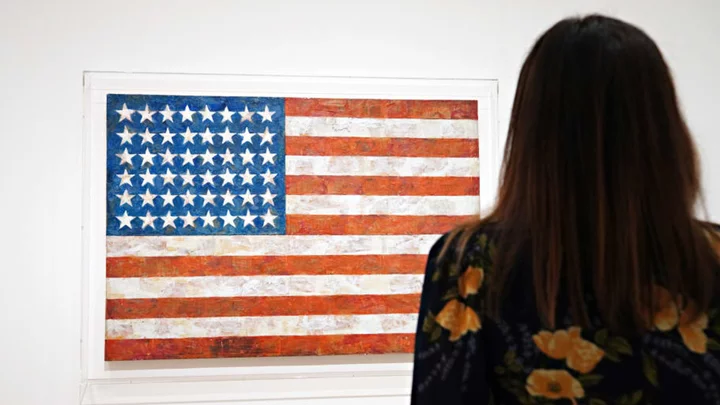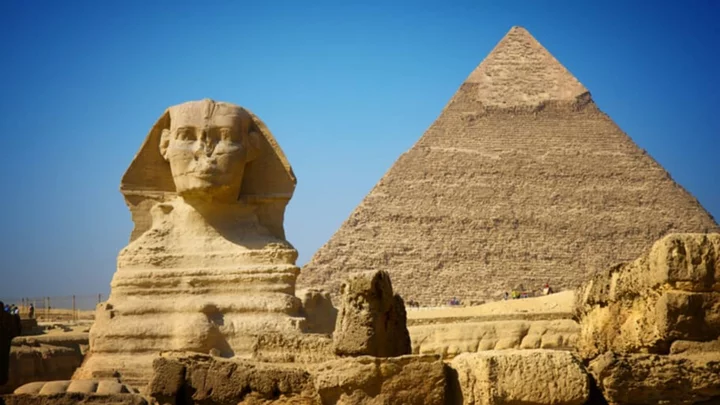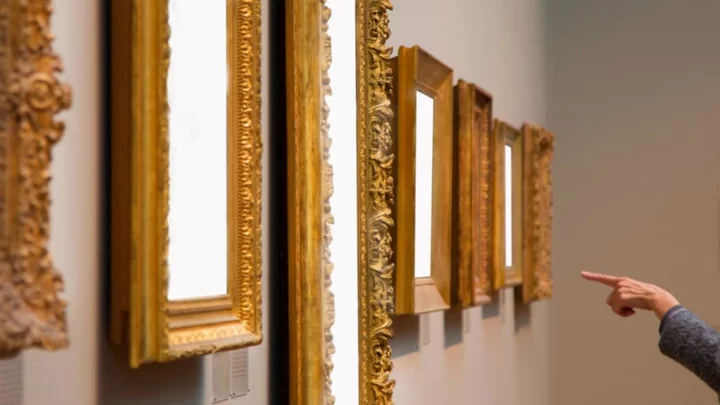American painter Jasper Johns shook up the art world by reconceptualizing common icons like targets, numbers, and letters—and it all began in 1954 with Flag.
1. Flag was painted after Jasper Johns left the military.
Johns—who was born in Georgia in 1930—served in the Army for two years during the Korean War and was stationed in South Carolina and Sendai, Japan. In 1953, the 23-year-old returned to New York City, where he’d previously spent a semester at the Parsons School of Design. He enrolled in Hunter College for a time, but dropped out; by 1954, he was primed to create what would become his most popular piece.
2. The painting began with a dream.
Johns has said that “One night I dreamed that I painted a large American flag. And the next morning I got up and I went out and bought the materials to begin it.”
3. Flag’s creation was proceeded by destruction.
In her book on Johns, art scholar Isabelle Loring Wallace wrote, “Johns did two things that would help establish his identity and significance as an artist. First, he systematically destroyed all existing work in his possession, vowing that henceforth his art would be free of perceptible debt to other artists. Secondly, he painted Flag.”
4. Flag may have roots in Johns’s first name.
During a 1990 conversation with Interview magazine, the artist looked back on his career and shared this potentially telling anecdote: “In Savannah, Georgia, in a park, there is a statue of Sergeant William Jasper,” Johns said. “Once I was walking through this park with my father, and he said that we were named for him. Whether or not that is in fact true or not, I don’t know. Sergeant Jasper lost his life raising the American flag over a fort.” Whether his father’s story was true or not, it seemed to have a major impact on the artist.
5. The painting defied the dominant trend of Abstract Expressionism.
The Abstract Expressionism propelled by the works of icons like Jackson Pollock in the 1940s was all the rage in the mid-1950s. But Johns rebelled against the movement’s emotional use of color and gesture, preferring common icons as inspiration.
As Johns explained it, “Using the design of the American flag took care of a great deal for me because I didn’t have to design it. So I went on to similar things like the targets—things the mind already knows. That gave me room to work on other levels.” With composition and color fixed, these items urged Johns to express himself in challenging new ways.
6. Instead, Flag is a Neo-Dadaist piece.
This movement embraces modern materials, popular imagery (like the American flag), and absurdity, while rejecting traditional aesthetics.
7. Unconventional materials give the work its distinctive look.
To build the base, Johns used three pieces of plywood and a bedsheet cut to size. Then, in the words of the Museum of Modern Art, he used “oil paint and then encaustic, a method involving pigmented melted wax. Johns dipped strips of cloth and newsprint into the hot wax and then affixed them to the sheet to fill in a penciled outline of the flag.” The paint’s texture causes the lumpy look of the brush strokes. Its translucence allows newspaper ink to poke through in parts of the painting. Johns's technique draws the viewer in, urging them to re-evaluate the iconic stars and stripes.
8. Johns haphazardly chose his paper strips.
Infrared photographs have shown a truly bewildering collage underneath Flag, from crossword puzzles to a receipt for a player piano as well as stock notices. But one of the stranger clippings is a panel from the comic Dondi. A visitor looking at the painting saw that the panel was clearly dated February 15, 1956, two years after the painting’s claimed completion date. A call to Johns revealed that the painting had been damaged during a party in 1956, and he’d repaired it with scraps of newspaper he had on hand.
9. Flag involved some trial and error.
“I worked on that painting a long time,” Johns said. “It’s a very rotten painting—physically rotten—because I began it in house enamel paint, which you paint furniture with, and it wouldn’t dry quickly enough. Then I had in my head this idea of something I had read or heard about: wax encaustic.” Encaustic dried quickly while also preserving Johns’s brushstrokes.
10. The method used for the painting has ancient origins.
Encaustic painting—also known as hot wax painting—dates back to at least the Romano-Egyptian Fayum mummy portraits of the 1st century. Back then, beeswax was used not only to bind pigments but to add a sculptural element to paintings. Modern heating implements made it much easier to employ the method, and Johns’s use of the 1900-year-old technique electrified the modern art world.
11. It’s huge.
Flag measures in at 42 1/4 inches by 60 5/8 inches, or over 3 1/2 feet by 5 feet.
12. Flag has been interpreted as both patriotic and unpatriotic.
Johns was a soldier who reclaimed his identity as an artist and re-imagined Old Glory as Flag. Created the same year the notorious McCarthy hearings drew to a close, the piece is assumed to have a political message, but no consensus has been formed on what that message is.
13. Political concerns may have spooked the Museum of Modern Art.
In 1958, Flag caught the eye of Alfred Barr, the director of the Museum of Modern Art (MoMA), when it was exhibited at the Leo Castelli Gallery. Though Barr wanted the piece for the museum’s collection, he feared there would be trouble if the public interpreted Flag as unpatriotic, so he urged architect Philip Johnson to pick up the piece for his private collection. Fifteen years later, when Barr was set to retire, Johnson gifted his beloved Flag to MoMA in the former director’s honor. The piece can still be found there today.
14. Johns refuses to solve Flag’s mystery.
Johns could clear up all the political mystery, but he insists that his works are intended to be open to the interpretation of the viewer. He has never cemented their meanings and instead refers to his paintings as “facts.”
15. Flag was just one of Johns’s many flag-inspired pieces.
Though Johns created more than 40 variations on the theme, the three that are best known are Flag, White Flag, and Three Flags. For White Flag, Johns also employed encaustic and newsprint, but scrapped the red and blue and added in charcoal. Three Flags, which stacks three increasingly smaller canvases, broke records in 1980 when it sold to the Whitney Museum of Art for $1 million, the highest price ever paid for a work by a living artist at the time. In 2010, another Johns flag painting from 1958 took that record again; the work was purchased by hedge fund billionaire Steven Cohen for a reported $110 million.
A version of this article was originally published in 2015 and has been updated for 2023.
This article was originally published on www.mentalfloss.com as 15 Fascinating Facts About Jasper Johns’s ‘Flag’.









